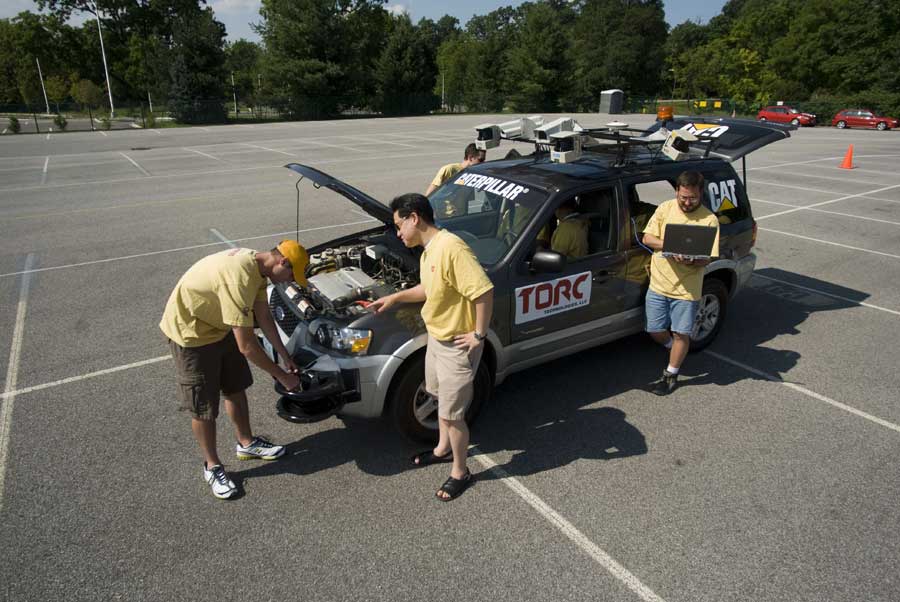Virginia Tech team qualifies as DARPA Urban Challenge semi-finalist

"VictorTango," a team of Virginia Tech engineering and geography students, will travel to Victorville, Calif., for the national qualifying rounds of the Urban Challenge autonomous vehicle competition, sponsored by the Defense Advanced Research Projects Agency (DARPA).
The Virginia Tech team is among 36 semi-finalists selected by DARPA to vie for the Urban Challenge prizes--$2 million for first place, $1 million for second, and $500,000 for third. After the Oct. 26-31 qualifying rounds, 20 teams will go to the starting gate for the final event on Nov. 3.
DARPA chose the former George Air Force Base in Victorville for the event because it has a network of urban roads that simulate the terrain U.S. forces operate in when deployed overseas. "The robotic vehicles will conduct simulated military supply missions at the site," said DARPA's director Tony Tether, who announced the semi-finalists and location on Aug. 9.
Victor Tango qualified for the semi-finals during a site visit DARPA judges made to Virginia Tech earlier this year. The team's vehicle successfully demonstrated its fully autonomous capabilities, driving a road course and interacting with human-driven vehicles (to view a video of the vehicle in action, visit the Victor Tango webpage.
Urban Challenge teams are attempting to develop vehicles that can maneuver a 60-mile course through traffic in less than six hours--with no human intervention allowed past the starting line. The vehicles will have to obey California traffic laws, merge into moving traffic, navigate traffic circles, negotiate intersections, and avoid moving obstacles.
In October 2006, VictorTango was one of only 11 "track A" teams chosen to receive $1 million contracts to develop autonomous vehicles capable of conducting simulated military supply missions in an urban setting. In all, 89 teams from universities and industry entered the competition in 2006.
In addition to the $1 million from DARPA, the Virginia Tech team received two Escape hybrid SUVs from Ford Motor Co., a $100,000 grant from Caterpillar, and additional sponsorship from National Instruments and several other corporations.
TORC Technologies LLC, a company in Virginia Tech's Corporate Research Center founded by alumni of the university's robotics program, has worked with VictorTango to develop the software for the vehicle's computer system.
VictorTango converted the two Escape hybrids--dubbed "Odin" by the students--into autonomous vehicles by outfitting them with a "drive-by-wire" system, a powerful computer system, laser scanners, cameras, and a GPS (global positioning system), said Patrick Currier, a Virginia Tech mechanical engineering (ME) graduate student from Murfreesboro, Tenn.
"The drive-by-wire system allows the computers to control the throttle, brake, steering, and shifting and to drive the vehicle," Currier said. "This system was custom developed by the team and is unique in that it is completely hidden from view, enabling Odin to retain full passenger capabilities."
Currier is one of 10 graduate students on the Virginia Tech team, which also has included as many as 50 undergraduates.
The students are guided by four faculty advisers, three of them from Virginia Tech--professor Alfred Wicks and assistant professor Dennis Hong of the College of Engineering's ME department, and geography department chair Bill Carstensen of the College of Natural Resources.
The team's founding adviser, Charles Reinholtz, a former Virginia Tech Alumni Distinguished Professor of ME and engineering education and now the chair of ME at Embry-Riddle Aeronautical University in Florida, continues to work with VictorTango.
"Odin is capable of driving on a marked road, following moving traffic, passing stopped vehicles, handling four-way intersections, and performing three-point turns," Currier said. The vehicle currently is being fine-tuned so that it can merge with moving traffic, pass moving vehicles, and park.
The team has outfitted Odin with four computers that perform specialized sensor processing and hardware interface tasks and two powerful servers that provide the primary computing power.
Laser scanners mounted on the bumpers and roof rack can detect large and small obstacles and the vehicle's own blind spot when it changes lanes or merges into traffic. Two cameras on the roof rack enable Odin to sense its location, identify its proper position in the traffic lane, and identify another vehicle. Odin's GPS has been designed to measure movement in all directions and to provide an accurate position, even if the GPS satellite signal is temporarily lost.
VictorTango and TORC developed Odin's sophisticated navigational software, which is modeled on human behavior. "To successfully navigate in an urban environment, Odin processes all of the sensor information, classifies the situation, and then chooses a behavior, such as passing another vehicle, staying in the lane, or parking," Currier explained. "This system makes Odin capable of choosing the best course out of millions of possible courses."
DARPA, the central research and development organization of the U.S. Department of Defense, is sponsoring the Urban Challenge as a more sophisticated follow-up to the two Grand Challenge competitions, which were held in 2004 and 2005 in the Mojave Desert. Virginia Tech competed in both of those contests, and the university's two entries placed eighth and ninth in 2005.



.png.transform/m-medium/image.png)
